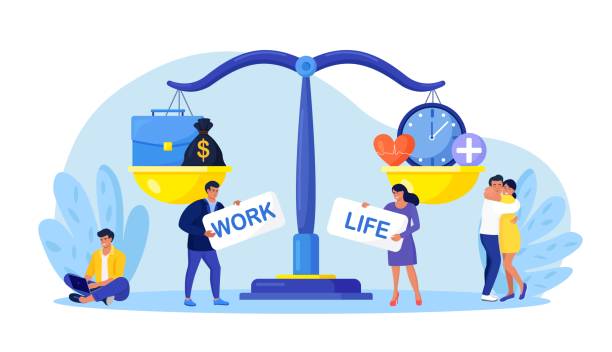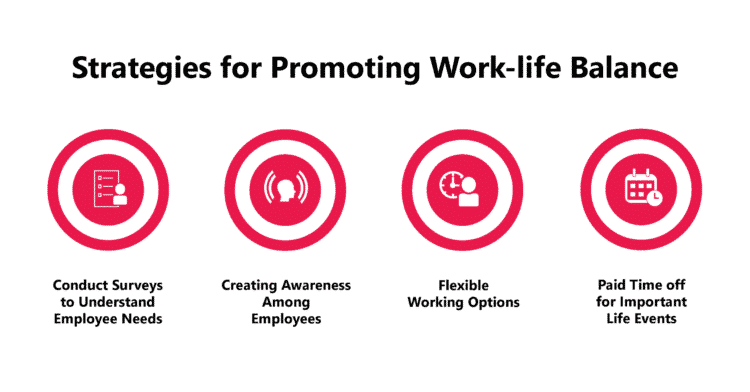 |
| Figure 01 |
Introduction
Importance of Employee Well-being
The health of employees is essential to the success of an organization. According to (Grabitch et al. 2006), workers are more likely to be engaged, productive, and content with their jobs when they have adequate assistance and are in good health. The organization as a whole as well as the employees themselves stand to gain when job satisfaction and turnover rates are reduced and employee well-being is given priority.
Definition of Work-Life Balance
The harmony between one's personal and professional obligations is referred to as work-life balance. It entails juggling job obligations with taking care of one's relationships and personal needs (Allen & Johnson, 2012). Reducing stress and preserving overall health is dependent upon achieving a work-life balance.
Understanding Employee Well-being
 |
Figure 02
|
An individual's general state of health, happiness, and life satisfaction is referred to as their "well-being." It includes a range of dimensions, such as:
- Physical well-being: According to (Grabitch Gottschalk and Munz 2006), this dimension is concerned with a person's physical health and vitality, encompassing things like exercise, diet, and getting enough sleep.
- Emotional health: Effectively understanding and controlling one's emotions, building resilience, and handling stress are all components of emotional well-being (Berg, Dutton, & Wrzesniewski, 2013).
- Mental well-being: This refers to both psychological and cognitive health, and it includes things like cognitive flexibility, problem-solving abilities, and keeping an optimistic outlook.
- Social well-being: According to (Kosek and Thompson 2016), social well-being is related to the caliber of a person's relationships and their sense of community at work.
The Impact of Employee Well-being on Organizational Performance
Employee happiness has a big impact on how effectively an organization performs. According to (Grabitch et al 2006), employees who receive adequate assistance and maintain good health are more likely to be engaged, motivated, and productive in their roles. Organizations that place a high priority on employee well-being also see a decrease in employee turnover, a decrease in absenteeism, and an increase in job satisfaction, which all contribute to increased productivity and profitability.
Factors Influencing Work-Life Balance
 |
| Figure 03 |
Achieving work-life balance is influenced by various factors in the workplace environment. These factors include:
- Demands of the Job and Workload: An employee's capacity to manage their personal and professional lives can be greatly impacted by the quantity and quality of the tasks they are allocated. People may find it difficult to set aside time for relationships and personal interests as a result of stress and burnout brought on by heavy workloads and unreasonable demands at work (Allen & Johnson, 2012).
- Flexibility in Work Arrangements: Work-life balance can be greatly aided by the flexibility provided by work arrangements, such as telecommuting choices, reduced workweeks, and flexible hours. Workers who can modify their work schedules to meet personal obligations typically report having a better work-life balance (Hill, Ferris, & Märtinson, 2003).
- Work-life Balance: Also influenced by leadership techniques and organizational culture, which can be supportive. An atmosphere where employees feel empowered to efficiently manage their work and personal responsibilities can be created by a supportive culture that prioritizes work-life balance, fosters employee well-being, and promotes open communication (Kossek & Thompson, 2016).
- Technology and Boundary Management: As a result of the blurring of work and personal life borders brought about by technological advancements, it is becoming increasingly difficult for people to put their work aside beyond regular business hours. In the current digital era, boundary management techniques like prioritizing work, regulating communication channels, and establishing clear boundaries are crucial for preserving work-life balance (Golden & Geisler, 2007).
Strategies for Promoting Employee Well-being and Work-Life Balance
 |
| Figure 04 |
Fostering work-life balance and employee well-being is crucial to establishing a positive and effective work environment. Employers may help their staff members strike a good work-life balance by putting in place a variety of initiatives. Among these tactics are the following:
- Employee Assistance Programs (EAPs): These programs offer private counseling and support services to staff members who are dealing with personal or professional challenges, such as stress, mental health disorders, or financial hardships. EAPs are a great place for staff members to go for support and advice on taking care of their health (Rothmann, 2008).
- Flexible Work Schedules: Offering flexible work schedules enables staff members to modify their working hours to better suit their preferences and personal responsibilities. Employees can have more influence over their work-life balance with this flexibility, which can include alternatives like flextime, reduced workweeks, or job-sharing arrangements (Hill, Ferris, & Märtinson, 2003).
- Remote Work Options: Employees who choose to work remotely can do so from places other than the typical office, such as their homes or cars. Employees who work remotely may benefit from increased flexibility and autonomy, which will help them better balance their personal and professional obligations (Golden & Veiga, 2005).
- Wellness Initiatives and Health Benefits: Employee well-being is enhanced by wellness initiatives and health benefits packages, which provide tools and assistance for both physical and emotional health. These programs, which encourage staff members to prioritize their health and well-being, could include wellness seminars, gym memberships, mental health resources, and health insurance coverage (Chapman et al., 2019).
- Sabbaticals and Time Off Policies: Employees have the opportunity to take extended breaks from work to rest, pursue personal interests, or spend time with their families thanks to sabbaticals and generous time off policies. Policies about vacation time and sabbaticals can reduce employee burnout, improve job satisfaction, and advance general well-being (Kossek & Lautsch, 2018).
Conclusion
In summary, work-life balance and employee well-being must be prioritized if an organization is to succeed. Organizations may use techniques such as wellness initiatives, flexible work schedules, remote work, EAPs, and sabbaticals more effectively when they have a thorough understanding of the components of well-being and the variables that impact work-life balance. Organizations that invest in these tactics foster an environment where workers flourish, which boosts output and achievement.
References
Grawitch, M. J., Gottschalk, M., & Munz, D. C. (2006). The path to a healthy workplace: A critical review linking healthy workplace practices, employee well-being, and organizational improvements. Consulting Psychology Journal: Practice and Research, 58(3), 129-147.
Allen, T. D., & Johnson, R. C. (2012). Work-family conflict and flexible work arrangements: Deconstructing flexibility. Personnel Psychology, 65(2), 247-282.
Berg, J. M., Dutton, J. E., & Wrzesniewski, A. (2013). Job crafting and meaningful work. In B. J. Dik, Z. S. Byrne, & M. F. Steger (Eds.), Purpose and meaning in the workplace (pp. 81-104). American Psychological Association.
Kossek, E. E., & Thompson, R. J. (2016). Work and family in the 21st century. Organizational Dynamics, 45(3), 157-165.
Allen, T. D., & Johnson, R. C. (2012). Work-family conflict and flexible work arrangements: Deconstructing flexibility. Personnel Psychology, 65(2), 247-282.
Hill, E. J., Ferris, M., & Märtinson, V. (2003). Does it matter where you work? A comparison of how three work venues (traditional office, virtual office, and home office) influence aspects of work and personal/family life. Journal of Vocational Behavior, 63(2), 220-241.
Kossek, E. E., & Thompson, R. J. (2016). Work and family in the 21st century. Organizational Dynamics, 45(3), 157-165.
Golden, A. G., & Geisler, C. (2007). Work-life boundary management and the personal digital assistant. Human Relations, 60(3), 519-551.




It's evident that understanding the components of well-being and factors affecting work-life balance is crucial for effective implementation. Your emphasis on investing in these tactics to create an environment where workers flourish speaks volumes about the value of employee-centric approaches.
ReplyDeleteBalancing the working environment with family is major fact
ReplyDeleteGood work
Timely relevant great topic
ReplyDeleteWork - life balance addresses how an organization's workforce prioritizes their personal and professional activities . Work - life balance is a timely matter given the increased amount of technology used to complete work activities and its ability to interrupt home life . Each employee defines their ideal work - life balance differently , depending on commitments to family , work priorities , health , and leisure .You selected a timely & valuable topic. wel done
ReplyDeleteGood topic for our industries, as this is not much in practice.
ReplyDeleteWoww... Impresive..
ReplyDeleteThe importance of work-life balance in promoting employee wellbeing and a positive work environment is expertly expressed in this article.
ReplyDeleteThis article deep dive into the interplay between work-life balance, employee well-being, and organizational performance and successfully addresses the complexities of the subject, with well-researched citations and clear examples. The explanation of different factors that influence work-life balance and the strategies to promote employee well-being are particularly noteworthy. The accompanying visuals effectively complement the text and make the article more engaging.
ReplyDeleteThank you for the review
DeleteExcellent job..
ReplyDeleteWork-life balance, which is impacted by company culture, technological management, work needs, and work arrangements, is essential for employees' well-being and productivity. This article clearly identifies how work-life balance helps organizations.
ReplyDeleteImpressive article and thank you for sharing with everyone.
Wow, what an insightful and inspiring blog! I really appreciate how you delved deep into the topic and provided practical tips. Your writing style is engaging and easy to follow, making it a pleasure to read. This blog post has truly motivated me to take action and implement some positive changes. Thank you for sharing your wisdom and expertise—I'm looking forward to reading more from you in the future
ReplyDeleteThe article impression of work life balance and well being employees , it is great effort to present in the current context.
ReplyDeleteWel explained work life balance
ReplyDelete